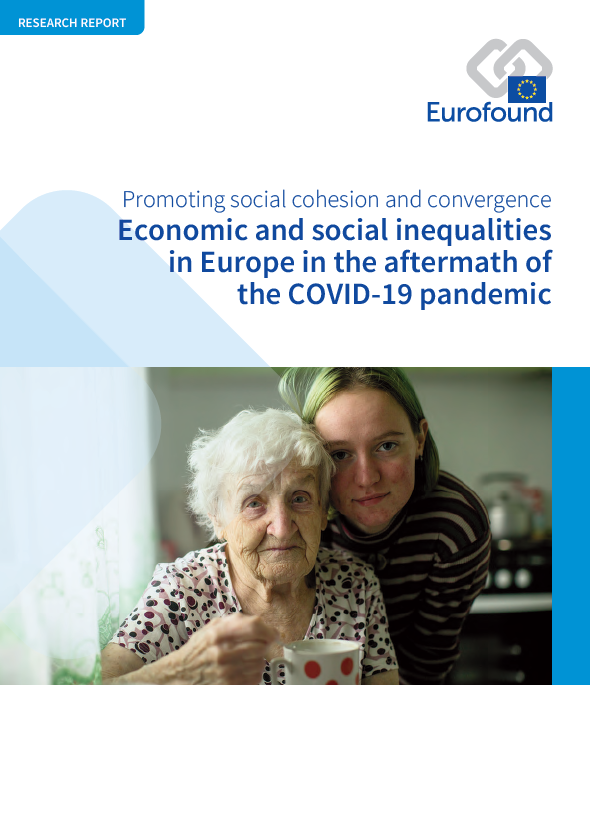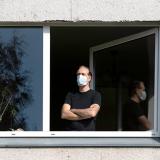
Η πανδημία COVID-19 είχε ποικίλες επιπτώσεις στις κοινωνικές ομάδες, ανάλογα με τα υφιστάμενα μειονεκτήματα, και ήταν κοινή πεποίθηση ότι προκάλεσε αύξηση των ανισοτήτων σε διάφορους τομείς της ζωής. Χρησιμοποιώντας δείκτες από το Multidimensional Inequality Monitoring Framework - MIMF (Πολυδιάστατο Πλαίσιο Παρακολούθησης της Ανισότητας) της ΕΕ, η παρούσα έκθεση δείχνει με ποιους τρόπους μεταβλήθηκε η ανισότητα στους τομείς του εισοδήματος, της υγείας, της απασχόλησης και της εκπαίδευσης κατά την περίοδο 2010-2020. Εξετάζει επίσης τους κύριους παράγοντες της εν λόγω αλλαγής κατά τη διάρκεια της πανδημίας και διερευνά τις σχέσεις μεταξύ των κυβερνητικών πολιτικών σε διάφορους τομείς και της ανισότητας.
Key findings
Το πρώτο έτος της κρίσης της νόσου COVID-19 συνεχίστηκε η μείωση της εισοδηματικής ανισότητας, επιβεβαιώνοντας την ισοπέδωση της ανισότητας στην ΕΕ. Ωστόσο, τα άτομα που αναζητούν εργασία και τα άτομα με χαμηλό και μεσαίο μορφωτικό επίπεδο ήταν πιθανότερο να αντιμετωπίσουν μείωση του εισοδήματός τους κατά τη διάρκεια της πανδημίας, καταδεικνύοντας ότι παρόλο που η εισοδηματική ανισότητα συνολικά μπορεί να μην αυξήθηκε κατά τη διάρκεια της νόσου COVID-19, η στενή παρακολούθηση του εν λόγω θέματος από τους υπεύθυνους χάραξης πολιτικής θα είναι καθοριστικής σημασίας στο πλαίσιο της τρέχουσας κρίσης λόγω της αύξησης του κόστους ζωής.
Η υγεία και η εισοδηματική ανισότητα συνδέονται στενά, με τους ανθρώπους με το κατώτερο πεμπτημόριο εισοδήματος να έχουν σχεδόν τριπλάσιες πιθανότητες να έχουν κάποια αναπηρία από ό, τι οι άνθρωποι στο ανώτερο 20 %. Κατά τη διάρκεια της πανδημίας, αυξήθηκε επίσης η ανισότητα στην πρόσβαση σε υπηρεσίες υγείας ανά κατηγορία εισοδήματος: το 2020, ο κίνδυνος να υπάρξει ιατρική ανάγκη η οποία δεν καλύπτεται για άτομα στο χαμηλότερο πεμπτημόριο εισοδήματος ήταν 5,4 φορές υψηλότερος από εκείνους στο ανώτερο 20 %, καταδεικνύοντας πώς οι πολιτικές που εστιάζουν στη μείωση των εισοδηματικών ανισοτήτων μπορούν επίσης να μειώσουν τις ανισότητες στον τομέα της υγείας.
Τα ευρήματα αποκαλύπτουν ότι η εργασία από το σπίτι κατά τη διάρκεια της πανδημίας μπορεί να δημιούργησε ανισότητες μεταξύ των ομάδων χαμηλού και υψηλού εισοδήματος, όπου οι προσωρινά απασχολούμενοι, οι νέοι και οι εργαζόμενοι σε επισφαλείς θέσεις απασχόλησης εμφανίστηκαν ως πιο ευάλωτοι σε κρίσεις. Για να διασφαλιστεί ότι αυτό δεν θα συνεχιστεί στον ολοένα και πιο ευέλικτο κόσμο της εργασίας μετά την πανδημία COVID-19, είναι σημαντικό για τους υπεύθυνους χάραξης πολιτικής να αντιμετωπίσουν το πρόβλημα των επισφαλών θέσεων απασχόλησης και να αυξήσουν τη διαφάνεια και την προβλεψιμότητα των συνθηκών εργασίας.
Κατά τη διάρκεια της πανδημίας, η ύπαρξη επαρκούς εξοπλισμού για τη διεξαγωγή ηλεκτρονικής μάθησης ήταν πιο σημαντική από το εισόδημα, καταδεικνύοντας τη σημασία της αντιμετώπισης του ψηφιακού χάσματος και της πρόσβασης στην τεχνολογία μακροπρόθεσμα για όλους. Οι γονείς και οι μαθητές που ζουν σε αγροτικές περιοχές και οι οποίοι δεν χρειαζόταν να μετακινούνται κατά τη διάρκεια της εν λόγω περιόδου, ήταν επίσης πιο πιθανό να είναι ικανοποιημένοι με την ποιότητα της διαδικτυακής εκπαίδευσης από εκείνους που ζουν στις πόλεις.
Η δυνατότητα εργασίας από το σπίτι δημιούργησε ανισότητες μεταξύ των ομάδων χαμηλού και υψηλού εισοδήματος, τονίζοντας την ανισότητα μεταξύ των φύλων όσον αφορά τη φροντίδα των παιδιών και τις οικιακές εργασίες. Το 2020, οι μόνες μητέρες ήταν πιθανότερο να μειώσουν τις ώρες εργασίας τους λόγω του κλεισίματος των σχολείων και των εγκαταστάσεων παιδικής φροντίδας – εάν οι γυναίκες συνεχίσουν να εργάζονται με περισσότερες ώρες μη αμειβόμενης παροχής φροντίδας από τους άνδρες, αυτό μπορεί ενδεχομένως να διευρύνει το μισθολογικό χάσμα μεταξύ των φύλων κατά τη διάρκεια της ανάκαμψης.
The report contains the following lists of tables and figures.
List of tables
Table 1: Indicators selected for the income inequality analysis
Table 2: OLS regression model exploring the relationship between government spending and inequality in making ends meet according to education level
Table 3: Panel OLS regression exploring general drivers of income inequality (1995–2020), EU27
Table 4: OLS regression model exploring drivers of income inequality between rural and urban households
Table 5: OLS regression model exploring income inequality by individual characteristics
Table 6: Logistic regressions on income inequality by individual characteristics
Table 7: Indicators selected for the health inequality analysis
Table 8: OLS regression model exploring the relationship between government expenditure and inequality in chronic disease
Table 9: Multilevel logit regression model on worsening health between 2019 and 2020
Table 10: Multilevel logit regression models on worsening health and mental health between 2019 and 2020
Table 11: Indicators selected for the employment inequality analysis
Table 12: OLS regression model exploring the relationship between government expenditure and inequality in opportunity in having a white-collar job
Table 13: OLS regression model exploring the relationship between gender inequality in occupations, childcare and paid leave at country level
Table 14: OLS regression model exploring the relationship between gender inequality in being employed, childcare and paid leave at country level
Table 15: Random effects within–between model showing the relationship between gender inequality in employment, over time and between countries
Table 16: Multilevel linear regression model on the number of hours worked in 2019 and 2020
Table 17: Multilevel linear regression model on the change in the number of hours worked between 2018 and 2019 and between 2019 and 2020
Table 18: Indicators selected for inequality in education analysis
Table 19: OLS regression model exploring the relationship between government spending and inequality in PISA scores
Table 20: Determinants of respondents’ satisfaction with the quality of their children’s online schooling (multilevel ordered logit model)
List of figures
Figure 1: Dimensions of life of the EU MIMF
Figure 2: Intersectional approach to effects of COVID-19 on inequality
Figure 3: Macro-, meso- and micro-level factors in income inequality during the COVID-19 pandemic
Figure 4: Heatmap showing the results of income inequality indicators by country, 2018–2019, EU27 and the UK
Figure 5: Income quintile share ratio (S80/S20) for equivalised disposable income, EU27
Figure 6: Gini coefficient of equivalised disposable income, EU27, Bulgaria, Greece and Poland
Figure 7: Odds ratio of a household having problems making ends meet (with versus without a tertiary education, 2018) against spending on education (2015, % of GDP), EU27 and the UK
Figure 8: Odds ratio of a household having problems making ends meet (with versus without a tertiary education, 2018) against spending on social protection (2015, % of GDP), EU27 and the UK
Figure 9: Scatterplot of government spending on social protection (% of GDP at time t–1) relative to the Gini index of disposable income at time t (1995–2020), EU27
Figure 10: Odds ratio of households having problems making ends meet (rural versus urban, 2018) against public investments in agricultural R&D (2015, % of GDP), EU27 and the UK
Figure 11: Households that reported that their income decreased in 2020 compared with the previous year by country (%), selected Member States
Figure 12: Households containing people aged 50+ that received financial support from the government due to the pandemic by country (%), selected European countries
Figure 13: Recipients of pandemic-related government support by country, EU27 (%)
Figure 14: Macro-, meso- and micro-level factors in health inequality during the COVID-19 pandemic
Figure 15: Heatmap presenting the results of health inequality indicators, 2018–2019, EU27 and the UK
Figure 16: Map of odds ratios of people reporting unmet medical care needs (women versus men, adjusted), 2018
Figure 17: Heatmap of odds ratio of feeling depressed for different social groups, 2018–2019, EU27 and the UK
Figure 18: Risk ratios of having a severe long-standing limitation in usual activities (disability) due to a health problem for various social groups (2010–2020), EU27
Figure 19: Risk ratios of having an unmet medical need due to high cost, distance to travel or waiting lists for various social groups (2010–2020), EU27
Figure 20: Government spending on education in 2002 (% of GDP) relative to ex ante inequality of opportunity in having two or more chronic diseases in 2019 (aged 50+), EU27
Figure 21: Macro-, meso- and micro-level factors in inequality in working life outcomes during the COVID-19 pandemic
Figure 22: Heatmap showing results of working life inequality indicators, 2018–2019, EU27 and the UK
Figure 23: Risk ratios of gender inequality in various dimensions of working life (2002–2020), EU27
Figure 24: Risk ratios of unemployment rates among various social groups (2002–2020), EU27
Figure 25: Risk ratios of employment rates among various social groups (2002–2020), EU27
Figure 26: Odds ratio of women being in employment versus men (2019) against the share of children under three years of age in formal childcare (2019, %), EU27
Figure 27: Average number of weekly hours worked in 2020 by country and contract type, selected EU Member States
Figure 28: Proportion of women who held second or third jobs by household type, 2020 (%)
Figure 29: Macro-, meso- and micro-level factors in inequality in education and learning during the COVID-19 pandemic
Figure 30: Heatmap showing results of education inequality indicators, 2018–2019, EU27 and the UK
Figure 31: Difference in tertiary education attainment as a whole in 55- to 74-year-olds and those with parents with a lower than tertiary education (2021)
Figure 32: Trends regarding inequality in education between women and men (2002–2020), EU27
Figure 33: Risk and odds ratios of NEET rates between various social groups (2004–2020), EU27
Figure 34: Government spending on education (2013, % of GDP) against P90/P10 PISA scores in mathematics (2018), EU27 and the UK
Figure 35: Parents’ satisfaction with the quality of online schooling for their children, EU27 (%)
Figure 36: Parents’ satisfaction with the quality of their children’s online schooling depending on whether they worked from home or not during the pandemic, EU27 (%)
- Number of pages
-
102
- Reference nº
-
EF22002
- ISBN
-
978-92-897-2309-1
- Catalogue nº
-
TJ-07-23-019-EN-N
- DOI
-
10.2806/439913
- Permalink
Cite this publication
Eurofound (2023), Economic and social inequalities in Europe in the aftermath of the COVID-19 pandemic, Publications Office of the European Union, Luxembourg.
